Ijraset Journal For Research in Applied Science and Engineering Technology
- Home / Ijraset
- On This Page
- Abstract
- Introduction
- Conclusion
- References
- Copyright
DermaSense AI: Revolutionizing Skin Disease Detection with Artificial Intelligence
Authors: Krishna Bharathi R, Ghriti B Amin, Keerthana RV, Rajha Sacheen VS
DOI Link: https://doi.org/10.22214/ijraset.2025.66474
Certificate: View Certificate
Abstract
The early detection and diagnosis of skin diseases are crucial for effective treatment and management. This paper presents DermaSense AI, an innovative platform that leverages Convolutional Neural Networks (CNNs), specifically the InceptionV3 architecture, to automate the detection of skin diseases with high accuracy. By integrating with Telegram, a popular messaging platform, DermaSense AI offers a user-friendly interface for preliminary diagnosis, enabling users to upload images for analysis. The system addresses challenges in dermatological care, such as limited access, high costs, and subjective diagnostics, by providing a scalable, cost-effective, and efficient solution. This study outlines the development, implementation, and testing of the DermaSense AI platform, demonstrating its potential to enhance dermatological care globally through accessible and reliable diagnostics.
Introduction
I. INTRODUCTION
Skin diseases, ranging from benign conditions like acne to severe disorders like melanoma, significantly impact global health. The accurate diagnosis and timely treatment of these conditions are critical for improving patient outcomes. However, barriers such as a shortage of dermatologists, high diagnostic costs, and limited access to care in rural areas hinder effective healthcare delivery.
Artificial Intelligence (AI), particularly through Convolutional Neural Networks (CNNs), has emerged as a transformative tool in medical diagnostics. CNNs excel in image recognition tasks, making them ideal for dermatological applications. DermaSense AI leverages the power of CNNs to provide accessible, accurate, and cost-effective diagnostic solutions via a Telegram-based interface. By addressing the limitations of traditional diagnostic methods, DermaSense AI aims to revolutionize dermatological care and empower users to take control of their skin health.
II. OBJECTIVES
DermaSense AI is designed with the following objectives:
- Improve Accessibility: Enable individuals in underserved regions to access dermatological diagnostics through an AI-powered platform, eliminating the need for in-person consultations.
- Facilitate Early Detection: Provide a reliable system for identifying skin diseases at an early stage, potentially preventing severe complications and reducing mortality rates associated with conditions like melanoma.
- Enhance Diagnostic Accuracy: Employ advanced CNN architectures, such as InceptionV3, to deliver high-precision diagnostic results, minimizing errors and ensuring user trust.
- Promote Scalability: Develop a robust infrastructure capable of accommodating thousands of users simultaneously without compromising performance or reliability.
- Educate Users: Integrate educational resources within the platform to raise awareness about common and rare skin diseases, emphasizing prevention and self-care practices.
- Reduce Healthcare Costs: Provide an affordable diagnostic alternative, particularly benefiting individuals who lack health insurance or reside in regions with limited medical facilities.
- Leverage Feedback for Continuous Improvement: Collect user feedback on diagnostic results to refine the AI model and expand its capabilities to cover more dermatological conditions.
- Ensure Data Privacy and Security: Implement stringent data protection measures, including encryption and anonymization, to safeguard user information and build confidence in the platform.
- Support Clinical Practices: Offer dermatologists a supplementary tool for rapid preliminary assessments, enhancing their diagnostic efficiency and clinical decision-making.
- Global Accessibility: Adapt the platform for multilingual support and region-specific customization to cater to diverse populations across the globe.
III. LITERATURE REVIEW
A. Application of AI in Dermatolog
AI has demonstrated significant potential in dermatological diagnostics. Esteva et al. (2017) highlighted that AI models could achieve dermatologist-level accuracy in melanoma detection. Similarly, platforms like SkinVision and MoleMapper utilize machine learning algorithms to assess skin lesions and track mole changes, providing users with preliminary insights. These platforms underline the transformative potential of AI in dermatology but also expose gaps in accessibility, scalability, and integration with clinical workflows.
B. Advances in CNN Architecture
Modern CNN architectures, including ResNet, VGGNet, and InceptionV3, have been extensively used for medical image analysis. InceptionV3, in particular, excels in feature extraction and classification due to its factorized convolutions, inception modules, and batch normalization techniques. Its ability to analyze high-dimensional data with minimal computational resources makes it suitable for real-time dermatological applications.
C. Datasets and Pre-processing
The success of AI in dermatology heavily relies on the availability of diverse and well-annotated datasets. The DermaNet dataset, used in DermaSense AI, includes thousands of labeled images across various skin conditions, ensuring robust model training and validation. Key preprocessing techniques such as resizing, normalization, and data augmentation improve model performance by addressing issues like dataset imbalance and variability in image quality.
D. Challenges and Limitations
Existing AI platforms face challenges including:
- Dataset Bias: Many datasets are geographically or demographically limited, reducing the generalizability of AI models.
- Interface Usability: Complex interfaces deter adoption among non-technical users.
- Explainability: Users often demand transparency in AI predictions, especially in critical healthcare decisions.
IV. METHODOLOGY
A. AI Model
The InceptionV3 CNN architecture was fine-tuned on the DermaNet dataset, which includes thousands of labeled dermatological images. The architecture is optimized for:
- Feature Extraction: Capturing fine-grained details like lesion shapes, textures, and color patterns.
- Classification: Differentiating between multiple skin conditions with high precision.
- Efficiency: Balancing computational resource usage and real-time analysis.
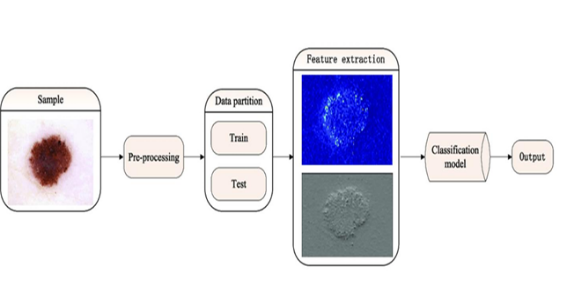
Fig 1 : Model Architecture
B. Image Preprocessing
Preprocessing techniques ensure the model’s robustness and generalizability:
- Resizing: Standardizing image dimensions for consistent input to the CNN.
- Normalization: Scaling pixel values to improve model convergence during training.
- Data Augmentation: Applying transformations like rotation, flipping, and zooming to expand the dataset and improve model resilience.
C. Workflow
- Users upload images via Telegram.
- The backend preprocesses the images to ensure compatibility with the AI model.
- The InceptionV3 model analyzes the images and generates probabilities for various skin conditions.
- A diagnostic report, including condition probabilities and recommended next steps, is sent to the user.
- User feedback is collected to refine model performance.
D. Integration with Telegram
The Telegram bot provides:
- Seamless Interaction: Intuitive commands for uploading images and receiving results.
- Notifications: Updates on report readiness and diagnostic insights.
- User Education: Access to information on common skin conditions and preventive care.
E. Validation and Testing
- Performance Metrics: Accuracy, precision, recall, and F1-score were calculated to evaluate the model.
- User Feedback: Surveys and usability tests were conducted to assess satisfaction and system reliability.

Fig 2 : Graph of training and validation accuracy
V. SOFTWARE REQUIREMENTS
A. Machine Learning Frameworks
- TensorFlow and Keras: Used for developing and training the InceptionV3 model. These frameworks provide tools for neural network implementation, optimization, and deployment.
- OpenCV: Utilized for preprocessing image data, including resizing and normalization.
B. Programming Languages
- Python: Forms the backbone of both backend development and AI model implementation. Its extensive libraries like NumPy, Pandas, and Matplotlib streamline data analysis and visualization.
C. Messaging Platform API
- Telegram Bot API: Facilitates real-time interaction between the user and the system, enabling image uploads, report delivery, and user feedback.
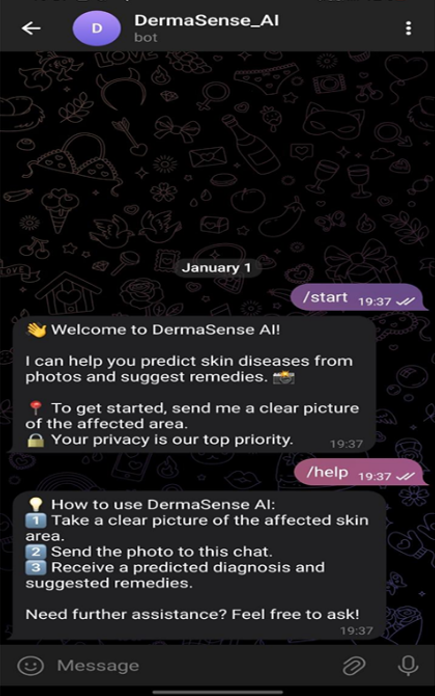
Fig 3 : Telegram bot
D. Database Management Systems
- MongoDB or Firebase: Used for efficient storage and retrieval of user details, images, and diagnostic results. These databases ensure scalability and security.
E. Cloud Computing Services
- Google Cloud Platform (GCP), AWS, or Azure: These services are vital for hosting the backend server, deploying the AI model, and ensuring high availability and low latency for user interactions.
F. Web Frameworks and APIs
- Flask or FastAPI: Used to build a robust backend server that integrates the Telegram bot, AI model, and database.
G. Monitoring and Logging Tools
- Prometheus and Grafana: Monitor the performance of the system in real time, ensuring reliability and quick identification of issues.
By combining these software components, DermaSense AI ensures seamless functionality, user-friendly interactions, and high diagnostic accuracy while maintaining data security and scalability.
VI. CONTROL FLOW
The control flow for DermaSense AI has been designed to optimize user interaction and system performance. Each step in the flow ensures accurate diagnostics and user satisfaction:
- User Interaction: Users initiate the diagnostic process by interacting with the Telegram bot, which serves as the primary interface. The bot guides users through image upload and other actions with clear instructions.
- Image Preprocessing: The system preprocesses the image for uniformity, enhancing image quality and ensuring compatibility with the AI model. This includes resizing, normalization, and augmenting the data if necessary.
- AI Model Analysis: The preprocessed image is sent to the InceptionV3 model for analysis. The model generates a probability distribution for possible skin conditions based on its training data.
- Result Compilation: A detailed diagnostic report is created, including the probabilities of various conditions and suggested next steps, such as consulting a dermatologist.
- User Feedback Collection: The bot prompts users for feedback on the diagnostic accuracy and overall experience. This information is stored and used for system improvement.
- Refinement and Updates: Based on user feedback and periodic retraining, the AI model and system components are updated to enhance performance and broaden diagnostic coverage.
VII. SYSTEM ARCHITECTURE
The system architecture of DermaSense AI ensures modularity, scalability, and security. Below are the detailed components and their functions:
- Frontend: The Telegram bot acts as the user interface, ensuring widespread accessibility and ease of use.Users interact with the bot to upload images, access results, and provide feedback.
- Backend Server: Processes user requests and coordinates between the frontend and AI model.Handles tasks such as image preprocessing, model inference, and report generation.
- AI Model: The InceptionV3 model is at the core of diagnostic operations, performing real-time analysis of uploaded images.Outputs a classification with probabilities for specific skin conditions.
- Database: Stores user data, images, diagnostic results, and feedback securely.Ensures compliance with data privacy regulations through encryption and anonymization.
- Cloud Integration: Cloud platforms like AWS or GCP host the backend and support dynamic scaling based on user demand.APIs facilitate smooth communication between components.
- Feedback Loop: The system incorporates a feedback mechanism to refine the AI model and improve user satisfaction.
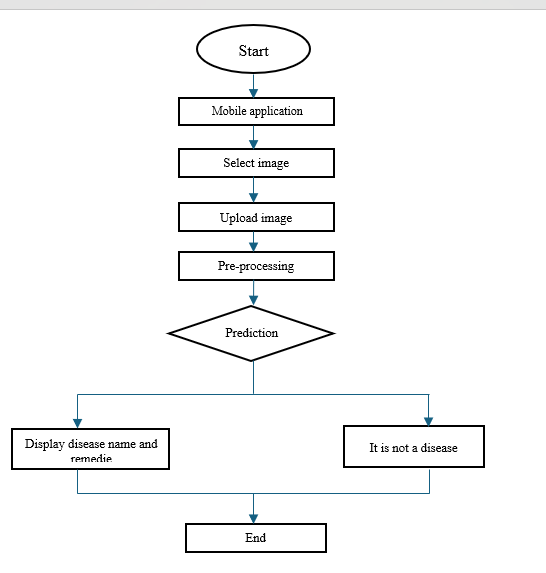
Fig 4 : User Interface
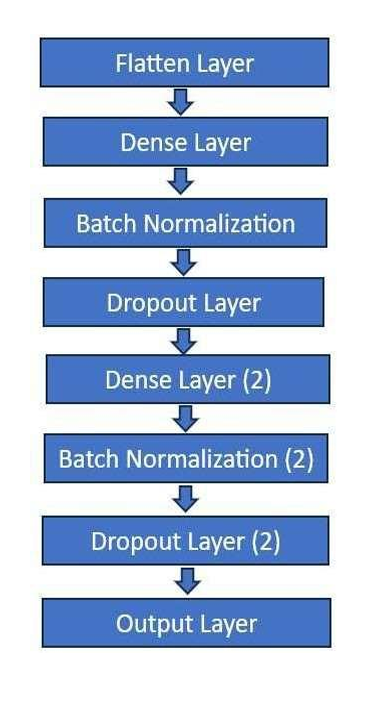
Fig 5 : CNN Architecture
VIII. IMPLEMENTATION
The process of implementing DermaSense AI involved several steps, starting with dataset preparation. The DermaNet dataset, which contains labeled images of various skin conditions, was used to train the machine learning model. Preprocessing techniques such as resizing images to match the input dimensions of the InceptionV3 architecture and normalizing pixel values were applied to improve model efficiency. Data augmentation methods, including rotation, flipping, and zooming, were employed to enhance dataset diversity and ensure robust performance.
This architecture utilized the Convolutional Neural Network model from InceptionV3. That architecture was best known for producing the most top-notch image recognition results, offering features like factorized convolutions in order to diminish computational costs; auxiliary classifiers mitigate vanishing gradients; and finally, global average pooling that works to reduce the chances of overfitting the model. Then, this network was implemented through TensorFlow and the Keras frameworks with an Adam optimizer and learning rate of 0.001. Multi-class classification was used with the categorical cross-entropy loss function and early stopping mechanisms to prevent overfitting.
This model was further integrated with a Telegram bot to deliver the system to end users in a user-friendly manner. Utilizing the Telegram Bot API, users could upload images from their skin conditions directly from within the Telegram platform. The Flask-based backend server handled image preprocessing, model inference, and communication with the bot. As soon as the image was submitted to the system, diagnostic results, including the probable condition and confidence scores, were delivered flawlesssly within seconds.
IX. RESULTS
The implementation successfully classified skin conditions with high accuracy and reliability. Through a Telegram bot, users were allowed to upload their images for more detailed diagnostic results, such as probable conditions and recommendations in real time. Case studies focused on how it could actually aid in proper preliminary diagnoses so as to allow access to prompt consultations with the help of physicians, thus illustrating potential improvements for better dermatological care, particularly for underdeveloped regions, based on this interface advanced by AI integration.
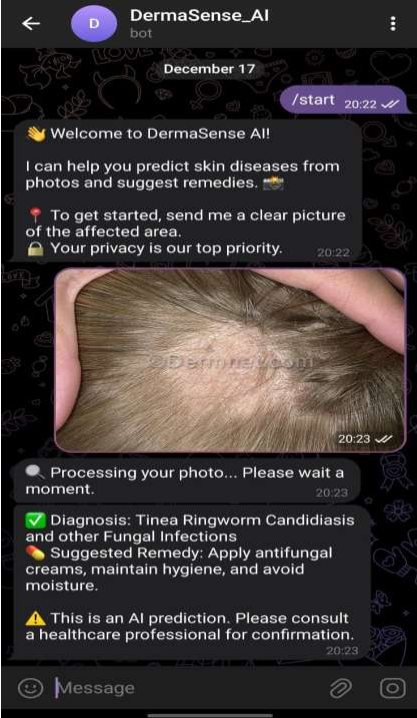
Fig 6 : Detection and Remedies
Conclusion
DermaSense AI represents a transformative leap in dermatological care by harnessing the power of artificial intelligence to offer precise, accessible, and affordable diagnostic services. Its seamless integration with Telegram ensures that users have a user-friendly experience, while the scalable backend architecture supports the platform’s potential to handle a growing number of users. These elements combine to make DermaSense AI not just a tool, but a comprehensive solution in dermatology. As the platform evolves, future developments will aim to broaden diagnostic capabilities, thereby increasing its reliability across a wider spectrum of skin conditions, including rare diseases. Enhanced model explainability will empower users by providing understandable and actionable insights, fostering trust and transparency. Moreover, by integrating with broader healthcare networks and launching dedicated mobile applications, DermaSense AI will ensure even greater accessibility and utility, bridging the gap between advanced AI diagnostics and everyday healthcare needs. This ongoing commitment to innovation and user-centric design positions DermaSense AI at the forefront of digital health solutions, revolutionizing the way dermatological care is delivered worldwide.
References
[1] Wongvibulsin, S., & Lee, I. (2025). Artificial Intelligence and Dermatology. JAMA Dermatology. [2] Frontiers in Medicine (2023). Principles, Applications, and Future of AI in Dermatology. [3] Satya-Akunuri, S. K., & Burkhart, C. G. (2023). Artificial Intelligence in Dermatology: Current Uses, Shortfalls, and Potential Opportunities for Further Implementation in Diagnostics and Care. The Open Dermatology Journal. [4] Liopyris, K., Gregoriou, S., Dias, J., & Stratigos, A. J. (2022). Artificial Intelligence in Dermatology: Challenges and Perspectives. Dermatology and Therapy, 12, 2637-2651. [5] Goyal, M., Yap, M. H. (2020). Artificial Intelligence in Dermatology: Current Uses and Future Opportunities. IEEE Journal of Biomedical and Health Informatics. [6] Esteva, A., et al. (2017). Dermatologist-level classification of skin cancer with deep neural networks. Nature, 542(7639), 115-118. [7] Szegedy, C., et al. (2016). Rethinking the Inception Architecture for Computer Vision. Proceedings of the IEEE Conference on Computer Vision and Pattern Recognition. [8] Ronneberger, O., et al. (2015). U-Net: Convolutional Networks for Biomedical Image Segmentation. MICCAI.
Copyright
Copyright © 2025 Krishna Bharathi R, Ghriti B Amin, Keerthana RV, Rajha Sacheen VS. This is an open access article distributed under the Creative Commons Attribution License, which permits unrestricted use, distribution, and reproduction in any medium, provided the original work is properly cited.

Download Paper
Paper Id : IJRASET66474
Publish Date : 2025-01-11
ISSN : 2321-9653
Publisher Name : IJRASET
DOI Link : Click Here
 Submit Paper Online
Submit Paper Online

